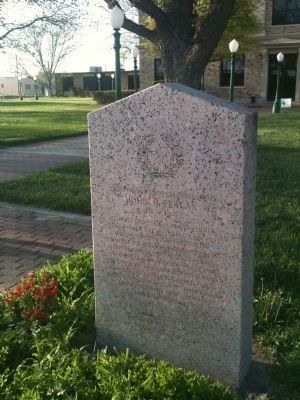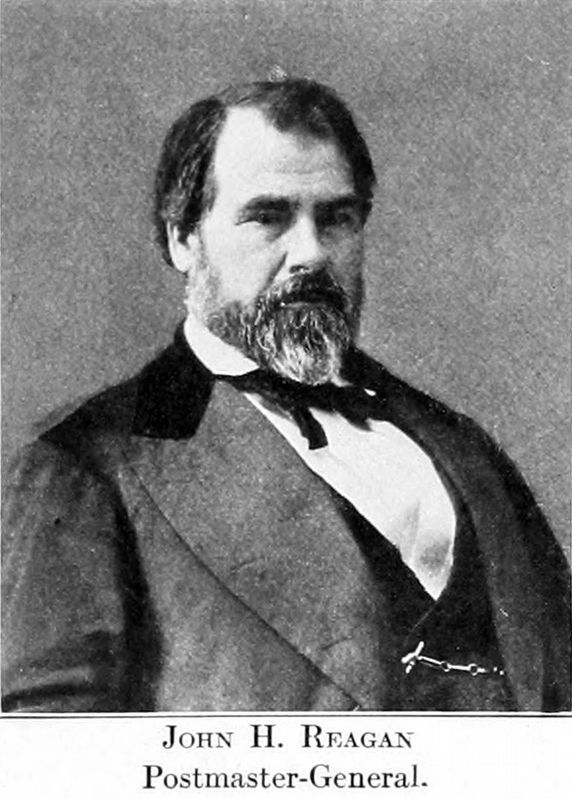Big Lake in Reagan County, Texas — The American South (West South Central)
John H. Reagan
John H. Reagan
1818-1905
A Memorial to Texans who served the Confederacy. Erected by the State of Texas 1963.
Erected 1963 by State of Texas. (Marker Number 2786.)
Topics. This historical marker is listed in this topic list: War, US Civil.
Location. 31° 11.558′ N, 101° 27.636′ W. Marker is in Big Lake, Texas, in Reagan County. Marker is at the intersection of East 3rd Street and North Plaza Avenue, on the right when traveling west on East 3rd Street. Located on south lawn of Reagan County courthouse. Touch for map. Marker is at or near this postal address: 300 North Plaza Avenue, Big Lake TX 76932, United States of America. Touch for directions.
Other nearby markers. At least 4 other markers are within 15 miles of this marker, measured as the crow flies. A different marker also named John H. Reagan (about 500 feet away, measured in a direct line); Martin-Castillo Expedition (about 500 feet away); City of Big Lake (approx. 0.9 miles away); Stiles Cemetery (approx. 14.9 miles away).
Also see . . . John H. Reagan. Entry in the Handbook of Texas Online. After the Civil War Reagan urged his fellow Texans to reconcile. In what became known as the "Fort Warren Letter," Reagan called for former Confederates to distance themselves from slavery and secession, recognize the authority of the United States, and to protect the voting rights of former slaves. (Submitted on May 1, 2012, by Craig Swain of Leesburg, Virginia.)
Additional commentary.
1. Postmaster General, Treasury Secretary Reagan
The true capitulation of the Confederacy happened when President Jefferson Davis was captured in Irwinville, Georgia, May 10, 1865. If escaped, the fugitive leader may have reestablished the dream in Texas, a state that had known only victory since the beginning of the war. Captured, it was the checkmate of a king. He was accompanied with First Lady, Varina H. Davis and the deeply loyal Texans Francis R. Lubbock and John H. Reagan. Lubbock was the anti-Houston governor turned aide-de-camp and
was held at Fort Delaware for eight months. Of the seven original states represented in the Davis administration, Reagan was the Texan and one of only three in the Cabinet (among Judah Benjamin of Louisiana and Stephen Mallory, Florida) that were close to Davis, the Mississippian. While on escape the President put the Confederate Postal Department on back burner and Reagan became Treasury Secretary. The final act of the CS Government was losing that department into the saddlebags, haversacks, and wagons of the President's military escort and then disbanding them. Reagan was held at Fort Warren in Massachusetts until November and Davis at Fort Monroe until 1867. Like other leading ex-Confederates including Robert E. Lee, John B. Gordon, and James Longstreet, Reagan asked the South to accept peace as much as the war had been about the defense of the South.
(With special reference to Secession and the Civil War by John H. Reagan, Personal Memoirs of Grant, Rise and Fall of the Confederate Government, and Texas Almanac 2012) Note To Editor only visible by Contributor and editor
— Submitted April 3, 2013, by Zacharias Beau T of Alpine, Texas.
Credits. This page was last revised on August 28, 2020. It was originally submitted on May 1, 2012, by Zacharias Beau T of Alpine, Texas. This page has been viewed 678 times since then and 22 times this year. Last updated on May 31, 2018, by Brian Anderson of Humble, Texas. Photos: 1. submitted on May 1, 2012, by Zacharias Beau T of Alpine, Texas. 2. submitted on December 9, 2018, by Allen C. Browne of Silver Spring, Maryland. • Bernard Fisher was the editor who published this page.

